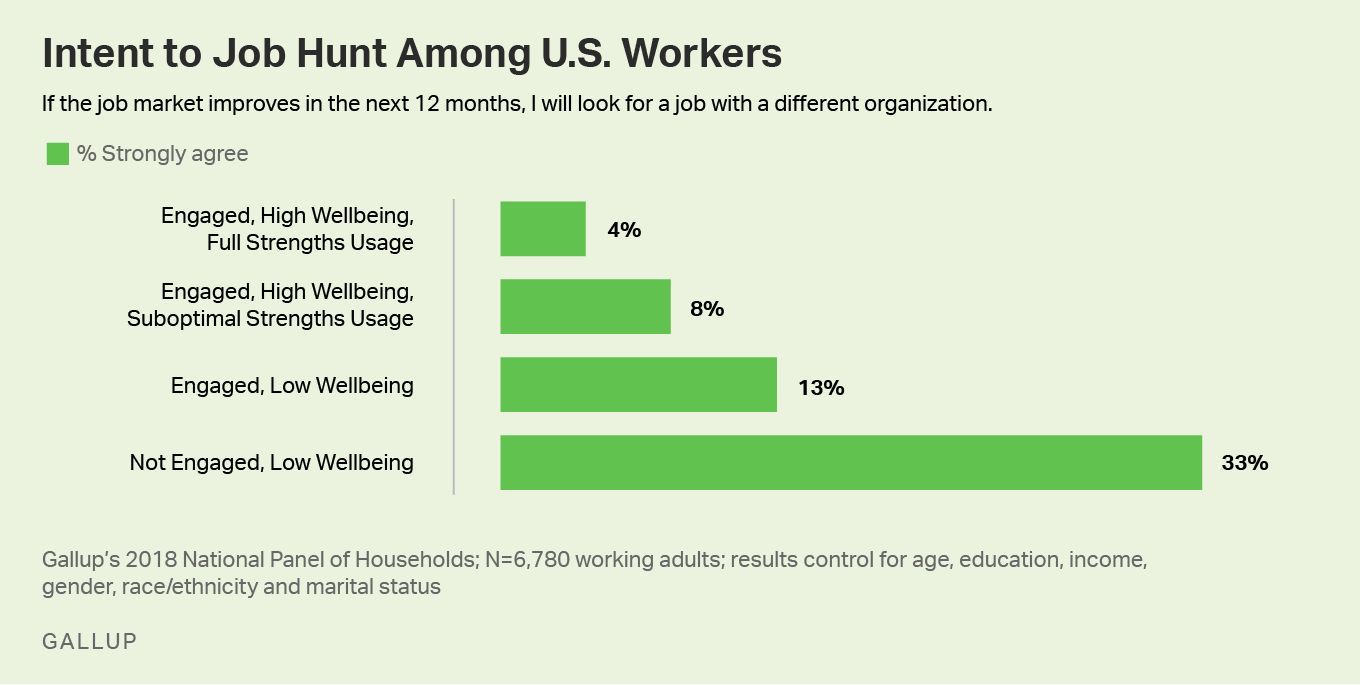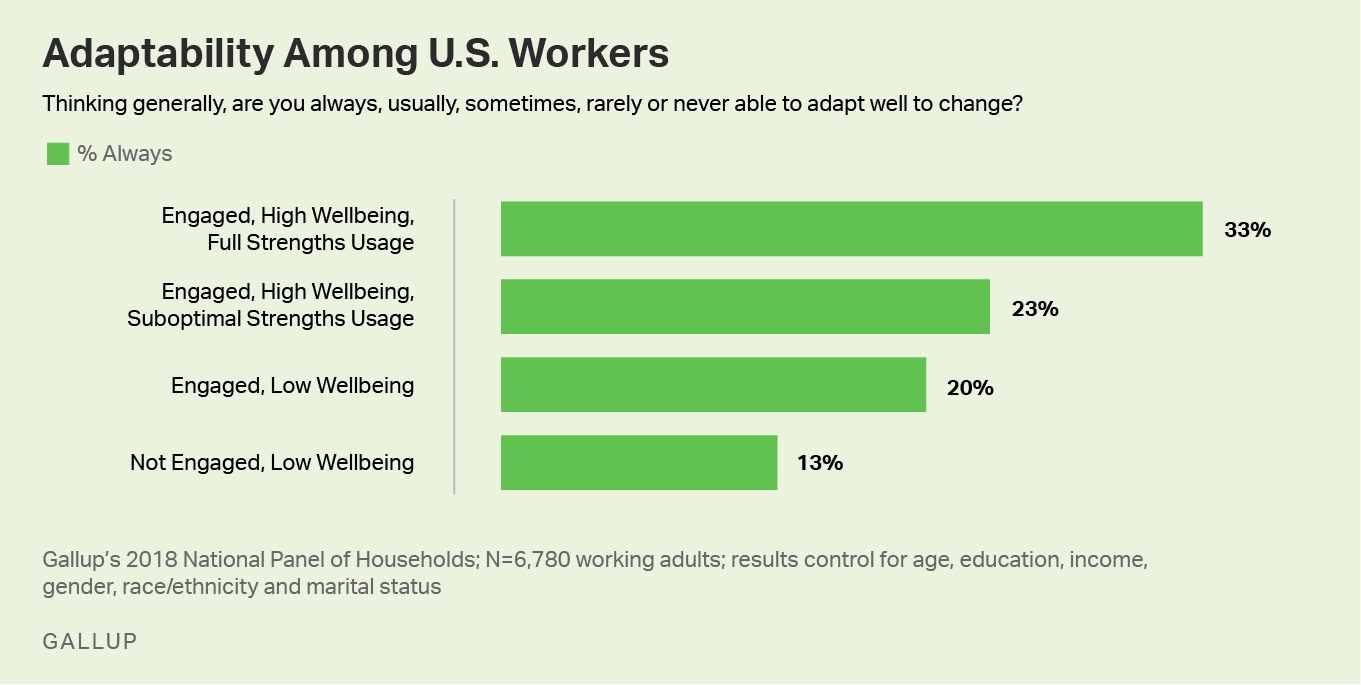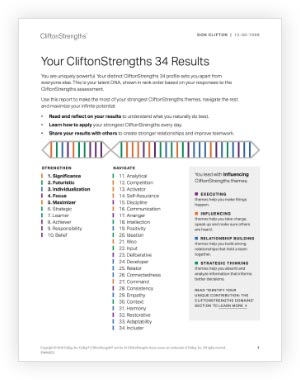Story Highlights
- Workers who are fully optimized outperform all others
- Just 7% of U.S. workers are fully optimized
- Optimize workers by connecting engagement, wellbeing and strengths
Leaders who are looking to take their organization to the next level of performance would be well-rewarded with an approach that balances employee engagement, wellbeing and strengths-based development. This is based on new research by Gallup that examines how these three disciplines, working in concert with one another, result in human and business outcomes that exceed what can be found through engagement and wellbeing alone.
Connecting Strengths With Engagement and Wellbeing
Past research has demonstrated the critical importance of holistic wellbeing (i.e., having high wellbeing across all five essential elements) compared with physical wellness alone in elevating key business outcomes. Highly engaged work teams, in turn, have been shown in a worldwide meta-analysis to have quadruple the odds of success in an overall composite metric of performance compared with poorly engaged teams. Furthermore, engagement and wellbeing are highly reciprocal, each influencing the future state of the other. And when studied in combination, high wellbeing enhances engagement, hoisting employee performance to levels not found through engagement alone.
But what about strengths? Strengths usage is also highly influential to both wellbeing and engagement. For example, workers who strongly agree that they use their strengths to do what they do best are substantially more likely to have high levels of wellbeing (i.e., to be "thriving") across all five elements: career, social, financial, community and physical. Employees whose strengths are the focal point of their managers -- about 37% of all workers -- are also vastly more likely to be engaged with their jobs (61%) than to be actively disengaged (1%), while those who are ignored are 40 times more likely to be actively disengaged.
Strengths usage is more than just a way to influence wellbeing or engagement, however. Strengths-based development has been shown to powerfully impact business performance in its own right -- with business units achieving increases of up to 7% in customer engagement, 15% in employee engagement and 29% in profit, coupled with decreases of up to 59% in safety incidents, 16 percentage points in turnover in low-turnover organizations and 72 points in turnover in high-turnover organizations. So, the question arises: How might the power of strengths combine with engagement and wellbeing in influencing workplace performance?
In other words, can the three working in tandem elevate performance still further?
The first step in answering this question is to determine actual strengths usage, which is modest. Nationally, only about half of all adults (49%) agree or strongly agree that they get to use their strengths to do what they do best every day, while about one in five (22%) disagree or strongly disagree, creating a significant strengths deficit. Among U.S. workers, these percentages improve only slightly to 55% and 16%, respectively. Just 11% of workers strongly agree.

This deficit grows substantially when viewed in combination with employee engagement and wellbeing. Among U.S. workers, nearly two-thirds (65%) are not engaged in their jobs and have lower overall wellbeing (i.e., have high levels of wellbeing in no more than three of the five elements). Another 22% are engaged but have lower wellbeing. Only about one in eight workers, therefore, have high wellbeing coupled with high engagement. But of these, just slightly over half strongly agree that they use their strengths to do what they do best. In other words, only 7% of U.S. workers are fully optimized in their jobs with high engagement, high wellbeing and full strengths usage.
| U.S. workers | |||||||||||||||||||||||||||||||||||||||||||||||||||||||||||||||||||||||||||||||||||||||||||||||||||
|---|---|---|---|---|---|---|---|---|---|---|---|---|---|---|---|---|---|---|---|---|---|---|---|---|---|---|---|---|---|---|---|---|---|---|---|---|---|---|---|---|---|---|---|---|---|---|---|---|---|---|---|---|---|---|---|---|---|---|---|---|---|---|---|---|---|---|---|---|---|---|---|---|---|---|---|---|---|---|---|---|---|---|---|---|---|---|---|---|---|---|---|---|---|---|---|---|---|---|---|
| % | |||||||||||||||||||||||||||||||||||||||||||||||||||||||||||||||||||||||||||||||||||||||||||||||||||
| Engaged, High Wellbeing, Full Strengths Usage | 7 | ||||||||||||||||||||||||||||||||||||||||||||||||||||||||||||||||||||||||||||||||||||||||||||||||||
| Engaged, High Wellbeing, Suboptimal Strengths Usage | 5 | ||||||||||||||||||||||||||||||||||||||||||||||||||||||||||||||||||||||||||||||||||||||||||||||||||
| Engaged, Low Wellbeing | 22 | ||||||||||||||||||||||||||||||||||||||||||||||||||||||||||||||||||||||||||||||||||||||||||||||||||
| Not Engaged, Low Wellbeing | 65 | ||||||||||||||||||||||||||||||||||||||||||||||||||||||||||||||||||||||||||||||||||||||||||||||||||
| N=6,780 working adults; results control for age, education, income, gender, race/ethnicity and marital status | |||||||||||||||||||||||||||||||||||||||||||||||||||||||||||||||||||||||||||||||||||||||||||||||||||
| Gallup's 2018 National Panel of Households | |||||||||||||||||||||||||||||||||||||||||||||||||||||||||||||||||||||||||||||||||||||||||||||||||||
So how do fully optimized workers perform relative to the other three groups across key business outcomes? In all cases -- without a single exception -- this special class of workers exhibited the highest level of performance, after controlling for age, education, income, gender, race/ethnicity and marital status. For example, job search intent over the next 12 months among workers who lack high engagement and high wellbeing is 33%. Engagement alone lowers this to just 13%, with high wellbeing on top of engagement (but still suboptimal strengths usage) bringing job search intent down to the single digits, at 8%. But when full strengths usage is included, job search intent is cut in half, to just 4%.

Adding full strengths usage to workers who already have high engagement and high wellbeing also powerfully impacts adaptability. While just 13% of workers with low wellbeing and low engagement report that they "always" adapt well to change, this percentage lifts to 23% -- a 76% increase -- if they have high engagement and high wellbeing (but still suboptimal strengths usage). Crucially, the probability of always adapting well to change climbs to 33% among fully optimized workers, a 43% jump compared with engaged and high wellbeing workers who are not fully using their strengths.

Perhaps most notable is the impact on the evaluation of leadership. When asked to rate their level of agreement with the leadership evaluation item ("There is a leader in my life who makes me enthusiastic about the future"), just 5% of U.S. workers with low engagement and low wellbeing strongly agree. Layering in engagement and wellbeing (without full strengths usage) boosts this figure by 18 points, to 23%. But adding full strengths usage has a decisive impact: Among these fully optimized workers, 46% strongly agree that their leader makes them enthusiastic about the future, double the rate reported among those with high engagement and high wellbeing but suboptimal strengths usage.

A full summary of all the outcomes that were examined in this study is found in the following table.
| Not Engaged, Low Wellbeing | Engaged, Low Wellbeing | Engaged, High Wellbeing, Suboptimal Strengths Usage | Engaged, High Wellbeing, Full Strengths Usage | Boost from adding strengths | |||||||||||||||||||||||||||||||||||||||||||||||||||||||||||||||||||||||||||||||||||||||||||||||
|---|---|---|---|---|---|---|---|---|---|---|---|---|---|---|---|---|---|---|---|---|---|---|---|---|---|---|---|---|---|---|---|---|---|---|---|---|---|---|---|---|---|---|---|---|---|---|---|---|---|---|---|---|---|---|---|---|---|---|---|---|---|---|---|---|---|---|---|---|---|---|---|---|---|---|---|---|---|---|---|---|---|---|---|---|---|---|---|---|---|---|---|---|---|---|---|---|---|---|---|
| % | % | % | % | % | |||||||||||||||||||||||||||||||||||||||||||||||||||||||||||||||||||||||||||||||||||||||||||||||
| Life Evaluation (% Thriving) | 52 | 65 | 89 | 93 | 4 | ||||||||||||||||||||||||||||||||||||||||||||||||||||||||||||||||||||||||||||||||||||||||||||||
| Leader in my life makes me enthusiastic about the future | 5 | 12 | 23 | 46 | 100 | ||||||||||||||||||||||||||||||||||||||||||||||||||||||||||||||||||||||||||||||||||||||||||||||
| No missed workdays due to poor health in the last month | 60 | 61 | 77 | 81 | 5 | ||||||||||||||||||||||||||||||||||||||||||||||||||||||||||||||||||||||||||||||||||||||||||||||
| Will look for a job in the next 12 months | 33 | 13 | 8 | 4 | -50 | ||||||||||||||||||||||||||||||||||||||||||||||||||||||||||||||||||||||||||||||||||||||||||||||
| Adapt well to change (% Always) | 13 | 20 | 23 | 33 | 43 | ||||||||||||||||||||||||||||||||||||||||||||||||||||||||||||||||||||||||||||||||||||||||||||||
| Bounce back fully after illness, injury or hardship (% Always) | 41 | 49 | 62 | 72 | 16 | ||||||||||||||||||||||||||||||||||||||||||||||||||||||||||||||||||||||||||||||||||||||||||||||
| Volunteered time to an organization in the last month | 59 | 64 | 72 | 79 | 10 | ||||||||||||||||||||||||||||||||||||||||||||||||||||||||||||||||||||||||||||||||||||||||||||||
| Rating own performance over last 12 months (% Excellent) | 22 | 45 | 51 | 64 | 25 | ||||||||||||||||||||||||||||||||||||||||||||||||||||||||||||||||||||||||||||||||||||||||||||||
| Rating team's performance over last 12 months (% Excellent) | 12 | 39 | 46 | 51 | 11 | ||||||||||||||||||||||||||||||||||||||||||||||||||||||||||||||||||||||||||||||||||||||||||||||
| Rating organization's performance over last 12 months (% Excellent) | 9 | 33 | 39 | 46 | 18 | ||||||||||||||||||||||||||||||||||||||||||||||||||||||||||||||||||||||||||||||||||||||||||||||
| N=6,780 working adults; results control for age, education, income, gender, race/ethnicity and marital status | |||||||||||||||||||||||||||||||||||||||||||||||||||||||||||||||||||||||||||||||||||||||||||||||||||
| Gallup's 2018 National Panel of Households | |||||||||||||||||||||||||||||||||||||||||||||||||||||||||||||||||||||||||||||||||||||||||||||||||||
What Leaders Can Do to Build Optimized Workers
First, it starts with simply recognizing the synergy among strengths, engagement and wellbeing and that their interactions represent clear opportunities to be leveraged. Getting leadership fully versed and committed to these principles is a required vanguard to successfully implementing the concepts in a practical manner.
Next, it involves taking a step back and realizing that it's hard to manage to someone's strengths if you don't know what they are. A critical, basic step for many organizations is to simply determine the unique strengths of everyone who works there.
The CliftonStrengths assessment and supporting online and in-person courses are designed to help people "name, claim and aim" their strengths. Once you have laid the foundation of strengths throughout the organization, you can begin to build your culture around them.
The final step, of course, is applying the principles in practice. One Gallup client, for example, is currently exploring the strengths-engagement-wellbeing relationship in one of its groups responsible for community outreach -- a smart strategy for improving community, social and career wellbeing alike. Teams are encouraged to sign up to support different community programs sponsored by their organization, with their leaders having ongoing conversations about how to introduce strengths and engagement initiatives into those teams in the context of the outreach. As these volunteers come together, their strengths can be explored to better understand who they are both individually and as a team and how this can be leveraged to help them successfully navigate the community projects they are working on. The 12 critical psychological needs of employee engagement can, in turn, be used to both prepare for and debrief the experience, such as:
- Are we clear on what is expected of us regarding this community project?
- Do we have what we need to succeed? Based on who we are as a group, is each person's set of strengths being kept in mind?
- Is my role on the project best aligned with my own personal strengths?
- Are we celebrating our successes on the project based on how each individual uniquely prefers to be recognized?
- Am I given the opportunity to propose ideas about how each person on the team can best contribute to the project, based on their individual aptitudes?
By weaving both strengths and engagement initiatives into organizational processes already aimed at driving wellbeing, leaders can fully benefit from existing opportunities. And by building robust coaching models aimed at capitalizing on the interactions among strengths, engagement and wellbeing, organizations can take their performance to the next level and fully leverage these indispensable components of optimized human potential.
Learn more about implementing a strengths-based approach to improve performance:
- Use Gallup Access for strengths-based tools, advice and learning tailored to you and your organization.
- Check out this episode of Gallup's webcast series, Called to Coach: How to Create a Strengths-Based Culture in Your Organization.
- Partner with Gallup to develop your leaders, managers and employees based on their unique talents.






